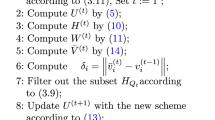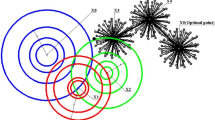Abstract
Fuzzy K-Means clustering (FKM) is one of the most popular methods to partition data into clusters. Traditional FKM and its extensions perform fuzzy clustering based on original high-dimensional features. However, the presence of noisy and redundant features would cause the degradation of clustering performance. To avoid this problem, we integrate fuzzy clustering and feature selection into a unified model where the structured sparsity-inducing norm is imposed on the transformation matrix to determine the valuable feature subse adaptively. The clustering task and feature selection process are promoted mutually. To solve this model, an iterative algorithm is developed. Extensive experiments conducted on benchmark data sets demonstrate the effectiveness of our proposed method.





Similar content being viewed by others
References
Cai D, He X, Han J (2005) Document clustering using locality preserving indexing. IEEE Trans Knowl Data Eng 17(12):1624–1637
Cai W, Chen S, Zhang D (2007) Fast and robust fuzzy c-means clustering algorithms incorporating local information for image segmentation. Pattern Recogn 40(3):825–838
Cannon RL, Dave JV, Bezdek JC (1986) Efficient implementation of the fuzzy c-means clustering algorithms. IEEE Trans Pattern Anal Mach Intell (2):248–255
Chang X, Wang Q, Liu Y, Wang Y (2016) Sparse regularization in fuzzy c-means for high-dimensional data clustering. IEEE Trans Cybern 47(9):2616–2627
Chatzis S, Varvarigou T (2008) Robust fuzzy clustering using mixtures of student’s-t distributions. Pattern Recogn Lett 29(13):1901–1905
Chen X, Cai D (2011) Large scale spectral clustering with landmark-based representation. In: Proceedings of the Twenty-Fifth AAAI Conference on Artificial Intelligence. AAAI Press, pp 313–318
Chen X, Hong W, Nie F, He D, Yang M, Huang JZ (2018) Spectral clustering of large-scale data by directly solving normalized cut. In: Proceedings of the 24th ACM SIGKDD international conference on knowledge discovery and data mining. Association for computing machinery, New York, pp 1206–1215
Chuang KS, Tzeng HL, Chen S, Wu J, Chen TJ (2006) Fuzzy c-means clustering with spatial information for image segmentation. Comput Med Imaging Graph 30(1):9–15
Dietterich TG, Bakiri G (1994) Solving multiclass learning problems via error-correcting output codes. J Artif Intell Res 2:263–286
Georghiades AS, Belhumeur PN, Kriegman DJ (2001) From few to many: illumination cone models for face recognition under variable lighting and pose. IEEE Trans Pattern Anal Mach Intell 23(6):643–660
Gorodnitsky I, Rao B (1997) Sparse signal reconstruction from limited data using focuss: a re-weighted minimum norm algorithm. IEEE Trans Signal Process 45(3):600–616
Graham DB, Allinson NM (1998) Characterising virtual eigensignatures for general purpose face recognition. In: Face recognition. Springer, pp 446–456
Guo L, Chen L, Lu X, Chen CP (2019) Membership affinity lasso for fuzzy clustering. IEEE Trans Fuzzy Syst 28(2):294–307
Huang J, Nie F, Huang H (2015) A new simplex sparse learning model to measure data similarity for clustering. In: Proceedings of the 24th international conference on artificial intelligence. AAAI Press, pp 3569–3575
Huang JZ, Ng MK, Rong H, Li Z (2005) Automated variable weighting in k-means type clustering. IEEE Trans Pattern Anal Mach Intell 27(5):657–668
Ji S, Ye J (2008) Generalized linear discriminant analysis: a unified framework and efficient model selection. IEEE Trans Neural Netw 19(10):1768–1782
Ji Z, Xia Y, Chen Q, Sun Q, Xia D, Feng DD (2012) Fuzzy c-means clustering with weighted image patch for image segmentation. Appl Soft Comput 12(6):1659–1667
Jing L, Ng MK, Huang JZ (2007) An entropy weighting k-means algorithm for subspace clustering of high-dimensional sparse data. IEEE Trans Knowl Data Eng 19(8):1026–1041
Li MJ, Ng MK, Cheung Ym, Huang J (2008) Agglomerative fuzzy k-means clustering algorithm with selection of number of clusters. IEEE Trans Knowl Data Eng 20(11):1519–1534
Li Y, Hu P, Liu Z, Peng D, Zhou JT, Peng X (2021) Contrastive clustering. In: Proceedings of the AAAI conference on artificial intelligence, vol 35, pp 8547–8555
Li Y, Yang M, Peng D, Li T, Huang J, Peng X (2022) Twin contrastive learning for online clustering. Int J Comput Vis:1–17
Liu H, Han J, Nie F, Li X (2017) Balanced clustering with least square regression. In: AAAI
Martinez A, Benavente R (1998) The ar face database CVC technical Report24
Ng AY, Jordan MI, Weiss Y (2001) On spectral clustering: analysis and an algorithm. In: Proceedings of the 14th international conference on neural information processing systems: natural and synthetic. MIT Press, Cambridge, pp 849–856
Nie F, Huang H, Cai X, Ding C (2010) Efficient and robust feature selection via joint ?<sub> 2,1</sub>-norms minimization. In: Proceedings of the 23rd International Conference on Neural Information Processing Systems - Volume 2. Curran Associates Inc., Red Hook, pp 1813–1821
Nie F, Xue J, Wu D, Wang R, Li H, Li X (2021) Coordinate descent method for k k-means. IEEE Trans Pattern Anal Mach Intell 44(5):2371–2385
Nie F, Zeng Z, Tsang IW, Xu D, Zhang C (2011) Spectral embedded clustering: a framework for in-sample and out-of-sample spectral clustering. IEEE Trans Neural Netw 22(11):1796–1808
Nie F, Zhao X, Wang R, Li X, Li Z (2022) Fuzzy k-means clustering with discriminative embedding. IEEE Trans Knowl Data Eng 34(03):1221–1230
Nie F, Zhao X, Wang R, Li X, Li Z (2022) Fuzzy k-means clustering with discriminative embedding. IEEE Trans Knowl Data Eng 34(3):1221–1230
Pal NR, Bezdek JC (1995) On cluster validity for the fuzzy c-means model. IEEE Trans Fuzzy Syst 3(3):370–379
Passerini A, Pontil M, Frasconi P (2004) New results on error correcting output codes of kernel machines. IEEE Trans Neural Netw 15(1):45–54
Peng X, Li Y, Tsang IW, Zhu H, Lv J, Zhou JT (2022) Xai beyond classification: interpretable neural clustering. J Mach Learn Res 23:6–1
Qian P, Jiang Y, Deng Z, Hu L, Sun S, Wang S, Muzic RF (2016) Cluster prototypes and fuzzy memberships jointly leveraged cross-domain maximum entropy clustering. IEEE Trans Cybern 46(1):181–193. 10.1109/TCYB.2015.2399351
Wang J, Su X, An improved k-means clustering algorithm (2011). In: 2011 IEEE 3rd international conference on communication software and networks, pp 44–46. https://doi.org/10.1109/ICCSN.2011.6014384https://doi.org/10.1109/ICCSN.2011.6014384
Wang X, Wu P, Xu Q, Zeng Z, Xie Y (2021) Joint image clustering and feature selection with auto-adjoined learning for high-dimensional data. Knowl-Based Syst 232:107443
Wang XD, Chen RC, Yan F, Zeng ZQ, Hong CQ (2019) Fast adaptive k-means subspace clustering for high-dimensional data. IEEE Access 7:42639–42651
Wold S, Esbensen K, Geladi P (1987) Principal component analysis. Chemom Intell Lab Syst 2(1):37–52. Proceedings of the Multivariate Statistical Workshop for Geologists and Geochemists
Wu KL, Yu J, Yang MS (2005) A novel fuzzy clustering algorithm based on a fuzzy scatter matrix with optimality tests. Pattern Recogn Lett 26(5):639–652
Xu J, Han J, Xiong K, Nie F (2016) Robust and sparse fuzzy k-means clustering. In: IJCAI, pp 2224–2230
Yu J, Yang MS (2005) Optimality test for generalized fcm and its application to parameter selection. IEEE Trans Fuzzy Syst 13(1):164–176
Yu J, Yang MS (2007) A generalized fuzzy clustering regularization model with optimality tests and model complexity analysis. Fuzzy Syst, IEEE Trans 15:904 – 915. https://doi.org/10.1109/TFUZZ.2006.889957https://doi.org/10.1109/TFUZZ.2006.889957
Zhang H, Li H, Chen N, Chen S, Liu J (2022) Novel fuzzy clustering algorithm with variable multi-pixel fitting spatial information for image segmentation. Pattern Recogn 121:108201
Zhang R, Li X, Zhang H, Nie F (2019) Deep fuzzy k-means with adaptive loss and entropy regularization. IEEE Trans Fuzzy Syst 28(11):2814–2824
Zhang R, Nie F, Guo M, Wei X, Li X (2018) Joint learning of fuzzy k-means and nonnegative spectral clustering with side information. IEEE Trans Image Process 28(5):2152–2162
Zhang R, Tong H, Xia Y, Zhu Y (2019) Robust embedded deep k-means clustering. In: Proceedings of the 28th ACM international conference on information and knowledge management, pp 1181–1190
Zhang Y, Bai X, Fan R, Wang Z (2019) Deviation-sparse fuzzy c-means with neighbor information constraint. IEEE Trans Fuzzy Syst 27(1):185–199. https://doi.org/10.1109/TFUZZ.2018.2883033https://doi.org/10.1109/TFUZZ.2018.2883033
hua Zhao Q, li Li X, Li Y, mei Zhao X (2017) A fuzzy clustering image segmentation algorithm based on hidden markov random field models and voronoi tessellation. Pattern Recogn Lett 85:49–55
Zhao X, Nie F, Wang R, Li X (2021) Robust fuzzy k-means clustering with shrunk patterns learning. IEEE Trans Knowl Data Eng. https://doi.org/10.1109/TKDE.2021.3116257
Zhao X, Nie F, Wang R, Li X (2022) Improving projected fuzzy k-means clustering via robust learning. Neurocomputing 491:34–43. https://doi.org/10.1016/j.neucom.2022.03.043
Zhi Xb, Fan Jl, Zhao F (2013) Fuzzy linear discriminant analysis-guided maximum entropy fuzzy clustering algorithm. Pattern Recogn 46(6):1604–1615
Acknowledgments
This work is supported by the Program for Innovative Research Team (in Science and Technology) in University of Henan Province (No. 22IRTSTHN016), the funding scheme of Key scientific research of Henan’s higher education institutions (No. 23A520010), the Key R & D and promotion Special Project of Science and Technology Department of Henan Province (No. 222102210104) and the teaching reform research and practice project of higher education in Henan Province in (No.2021SJGLX502).
Author information
Authors and Affiliations
Corresponding author
Additional information
Publisher’s note
Springer Nature remains neutral with regard to jurisdictional claims in published maps and institutional affiliations.
Rights and permissions
Springer Nature or its licensor (e.g. a society or other partner) holds exclusive rights to this article under a publishing agreement with the author(s) or other rightsholder(s); author self-archiving of the accepted manuscript version of this article is solely governed by the terms of such publishing agreement and applicable law.
About this article
Cite this article
Zhao, P., Zhang, Y., Ma, Y. et al. Discriminatively embedded fuzzy K-Means clustering with feature selection strategy. Appl Intell 53, 18959–18970 (2023). https://doi.org/10.1007/s10489-022-04376-5
Accepted:
Published:
Issue Date:
DOI: https://doi.org/10.1007/s10489-022-04376-5




